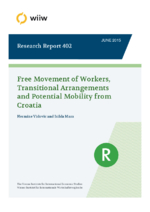Free Movement of Workers, Transitional Arrangements and Potential Mobility from Croatia
Isilda Mara and Hermine Vidovic
wiiw Research Report No. 402, June 2015
49 pages including 15 Tables and 14 Figures
Summary
International migration from Croatia has a long tradition and has been diverse and complex. The labour migration initiated in the 1960s still has a lasting effect on subsequent migration flows, particularly with regard to destination countries. Despite transitional arrangements in place in the major destination countries – Germany, Austria, Italy and Slovenia – a preliminary assessment of recent data shows that employment of Croatian nationals in these countries (except Italy) has increased after Croatia’s EU accession. The main reasons for working abroad, as stated by potential movers, are the poor economic situation in Croatia, a better standard of living and higher career opportunities abroad as well as gaining work experience. The support of networks, e.g. friends, family and acquaintances living already in the country of destination, play a critical role for Croatian citizens wanting to work abroad and are important sources of information about job opportunities in other countries. Surveys indicate that potential migration in 2014 was much higher than it had been prior to accession. Typical (potential) migrants are young, unmarried, and highly educated. Different scenarios of potential migration have been projected. Under a scenario assuming the lifting of restrictions in accessing labour markets from July 2015, the stock of Croatian migrants is likely to increase by 217,000 (from 335,000 in 2013 to 552,000 in 2019). Accordingly, net migration because of the regime change is expected to be an additional 50,000 migrants compared to 167,000 projected under a scenario assuming that the status quo will apply to the entire seven-year period (July 2013 to July 2020) of transitional arrangements. In terms of origin-country population, net migration would account for a share of 3.9% and 5.1%, respectively, under the lower/upper bound of projections. Nevertheless, the stock of Croatian migrants as a share of EU population will continue to remain relatively low, hardly exceeding 0.1% under the different scenarios. Croatian migrants are expected to continue to migrate mainly towards those EU Member States that have been historically their main destination countries.
Reference to wiiw databases: wiiw Annual Database
Keywords: mobility from Croatia, potential migration surveys, migration projections, gravity model
JEL classification: J11, J61, F22
Countries covered: Croatia, European Union
Research Areas: Labour, Migration and Income Distribution
